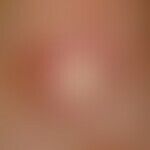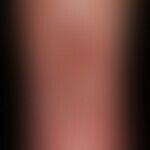Synonym(s)
DefinitionThis section has been translated automatically.
EtiopathogenesisThis section has been translated automatically.
- Arteriosclerosis, endangiitis obliterans, angiopathy in diabetes mellitus, embolism, aneurysms, polyarteritis nodosa, hypertension ( hypertensive leg ulcer).
- Risk factors: smoking, hypercholesterolemia, lipometabolic disorders, hypertension, diabetes mellitus, among others.
You might also be interested in
LocalizationThis section has been translated automatically.
The predilection sites are mainly the outer ankle, (outer) edge of the foot, as well as the heels and toes.
Clinical featuresThis section has been translated automatically.
Depending on the aetiology, acute or slow development of a painful, sharply defined ulceration, possibly spreading to the fascia. Compared to the venous leg ulcer, it is usually very painful. The skin around the ulcer is cold and pale (Fußpulse↓).
LaboratoryThis section has been translated automatically.
DiagnosisThis section has been translated automatically.
- Medical history: Family history, concomitant diseases, risk factors such as occupational stress and sporting activities, operations or trauma to the lower extremities and the pelvic girdle region, number and complications of pregnancies or thromboses.
- Clinic, laboratory
- Diagnostic equipment: Doppler sonographic determination of the ankle-arm index (Ankle-Brachial-Index, ABI) arterial duplex sonography of the relevant inflow areas; arterial digital subtraction angiography; angio-magnetic resonance imaging, radiological exclusion of bone involvement.
General therapyThis section has been translated automatically.
Treatment of the underlying disease and the causative factors (e.g. cessation of diabetes mellitus). Switching off the risk factors (e.g. smoking, hypertension, etc.). To prevent recurrence, consistent compression therapy and mobilisation, possibly lymph drainage in the case of oedema.
A consistent lifestyle change should be made in all stages of PAVK. Patient training can be helpful here.
From stage I on, treatment with statins is recommended in the presence of hypercholesterolemia.
In stage II, daily 30-60 minute walking training is recommended. In addition, therapy with an antiplatelet aggregation inhibitor(ASS or Clopidogrel) is recommended.
Surgical therapy is recommended for stage III of PADK.
In stage IV the extremity should be relieved.
External therapyThis section has been translated automatically.
Internal therapyThis section has been translated automatically.
- Accompanying therapy with vasoactive substances such as prostaglandin E1 (e.g. Prostavasin 20) 1 amp. in 50 ml 0.9% NaCl solution over 60-120 min. infuse or 2 times/day 40-60 μg in 50-250 ml 0.9% NaCl solution over 2 hours i.v.
- Alternatively pentoxifylline (e.g. Trental) 1-2 times/day 100-600 mg in 100-500 ml infusion solution over 60 min. i.v., naftidrofuryl hydrogen oxalate (e.g. Dusodril) 300-600 mg/day p.o. In addition, rheological measures such as volume replacement with HAES. Cave! HAES-induced pruritus! Possibly bloodletting. The HKT should be around 35-40%.
Operative therapieThis section has been translated automatically.
Notice! Gait training is contraindicated in stage IV of AVK!
Incoming links (5)
Mixed ulcus cruris; Primary cutaneous diffuse large cell b-cell lymphoma leg type; Pyoderma gangraenosum; Tropic ulcer ; Venous leg ulcer;Outgoing links (11)
Acetylsalicylic acid; Arterial occlusive disease peripheral; Clopidogrel; Duplex sonography; Hydroxyethyl starch; Hypertonic leg ulcer; Naftidrofury oxalate; Pentoxifylline; Polyarteritis nodosa systemic; Thrombangiitis obliterans; ... Show allDisclaimer
Please ask your physician for a reliable diagnosis. This website is only meant as a reference.











